Chapter 1 An Introduction to Information Systems PDF

| Title | Chapter 1 An Introduction to Information Systems |
|---|---|
| Author | alfredo Fernandez |
| Course | Basic Information Systems |
| Institution | University of North Texas |
| Pages | 12 |
| File Size | 186.5 KB |
| File Type | |
| Total Downloads | 46 |
| Total Views | 173 |
Summary
Download Chapter 1 An Introduction to Information Systems PDF
Description
Name:
Class:
Date:
Chapter 1 - An Introduction to Information Systems True / False 1. Information is simply a collection of raw facts such as an employee number or the total hours worked in a week. a. True b. False ANSWER: False 2. Data represents real-world things including raw facts such as image and audio data. a. True b. False ANSWER: True 3. A set of random or unrelated tasks performed to achieve a definite outcome is called a process. a. True b. False ANSWER: False 4. The term data is used to label raw facts such as height and weight of a patient. a. True b. False ANSWER: True 5. Using a computer to forecast future sales and order more inventory before a shortage can occur is an example of information system feedback. a. True b. False ANSWER: False 6. A computer-based information system (CBIS) is a single set of hardware, databases, networks, people, and procedures configured to collect, manipulate, store, and process data into information, but the CBIS does not include software. a. True b. False ANSWER: False 7. Components of a computer-based information system include people such as the CIO (chief information officer) and end-users. a. True b. False ANSWER: True 8. Increasingly, companies are no longer incorporating computer-based information systems into their products and services. a. True b. False ANSWER: False Copyright Cengage Learning. Powered by Cognero.
Page 1
Name:
Class:
Date:
Chapter 1 - An Introduction to Information Systems 9. An example of the concept of feedback is a factory information system that is programmed to alert the manager if there is any decrease in productivity so the manager can take corrective steps to improve productivity. a. True b. False ANSWER: True 10. Either system software or application software, but not both, are needed for all types of computers. a. True b. False ANSWER: False 11. Application software, such as Microsoft Word, manages basic computer operations such as start-up. a. True b. False ANSWER: False 12. QuickBooks is an accounting application used by many large, multinational organizations. a. True b. False ANSWER: False 13. Organizations invest heavily in information systems to improve customer service. a. True b. False ANSWER: True 14. The World Wide Web (WWW) is a network of links on the Internet to documents containing text, graphics, video, and sound, but does not offer cloud computing capabilities. a. True b. False ANSWER: False 15. An intranet is a network based on Web technologies that allows selected outsiders, such as business partners and customers, to access authorized resources of a company’s extranet. a. True b. False ANSWER: False 16. Since the 1950s, computers have been used to perform common business applications. a. True b. False ANSWER: True 17. When you buy books from another consumer through an online auction site such as eBay.com, you are involved in ecommerce. Copyright Cengage Learning. Powered by Cognero.
Page 2
Name:
Class:
Date:
Chapter 1 - An Introduction to Information Systems a. True b. False ANSWER: True 18. Mobile commerce (m-commerce) is the use of mobile, wireless devices to place orders and conduct business. a. True b. False ANSWER: True 19. A database is essential to the operation of a computer-based information system. a. True b. False ANSWER: True 20. Electronic business (e-business) goes beyond e-commerce and e-procurement by using information systems and the Internet to perform business-related tasks and functions. a. True b. False ANSWER: True 21. When a customer buys products using the company's website, it results in transactions that are recorded for later use by management information systems. a. True b. False ANSWER: True 22. A management information system (MIS) is exactly the same as a transaction processing system (TPS); the two terms can be used interchangeably. a. True b. False ANSWER: False 23. Systems development projects should always be outsourced in order to allow an organization to focus on what it does best. a. True b. False ANSWER: False 24. Usability and user-interface design are key factors in delivering apps that business users will adopt and use. a. True b. False ANSWER: True 25. When an organization uses cloud computing, they do not have to buy and maintain expensive hardware. a. True Copyright Cengage Learning. Powered by Cognero.
Page 3
Name:
Class:
Date:
Chapter 1 - An Introduction to Information Systems b. False ANSWER: True 26. Another name for the World Wide Web is the Internet of Things. a. True b. False ANSWER: False 27. When a business finds that many of its business applications have to be updated or rewritten, it will be better if they replace them with an ERP system. a. True b. False ANSWER: False 28. If a hotel wishes to determine where to spend resources on renovations - on interior decor or on curb appeal or on recreational facilities - they would use business intelligence to make the decision. a. True b. False ANSWER: True 29. Natural language processing involves the computer interacting in natural languages - like spoken English. a. True b. False ANSWER: True 30. Cybercriminals are hackers who try to steal business information or government data related to a nation's infrastructure, all for personal gain. a. True b. False ANSWER: False Multiple Choice 31. The process of defining relationships among data to create useful information requires ______. a. an information system b. a formal education c. knowledge d. intuition ANSWER: c 32. A clothing store chain tracks the sale of each product at each location. Managers use this information to calculate the organization's profits, to track inventory needs, and to determine which styles and fabrics are the most popular among its customers. This is an example of quality information that is ___________. a. flexible b. economical c. relevant d. verifiable ANSWER: a 33. The value of information is directly linked to how it helps decision makers achieve their organization’s _____. Copyright Cengage Learning. Powered by Cognero.
Page 4
Name:
Class:
Date:
Chapter 1 - An Introduction to Information Systems a. cost/profit target c. cost reduction initiatives ANSWER: b
b. goals d. customer satisfaction levels
34. In terms of information systems, Wikipedia would be an example of _________. a. a personal IS b. a group IS c. an enterprise IS d. an organizational complement ANSWER: b 35. Which of the following is NOT an organizational complement? a. well-trained workers b. system support c. new decision rights d. familiar processes ANSWER: d 36. All of the following are functions of a knowledge management system EXCEPT: a. storing and retrieving b. improving collaboration. knowledge. c. locating knowledge sources. d. designing information systems. ANSWER: d 37. Which of the following does not is NOT an application software? a. Quicken b. Android c. SAP d. QuickBooks ANSWER: b 38. When the IS organization and its resources are focused on efforts that support the key objectives defined in the managers' strategic plan for the business, the organization is in _________. a. alignment b. compliance c. development d. construction ANSWER: a 39. Federal Express (FedEx) was one of the first large companies to empower customers to serve themselves at their convenience through the use of _____. a. a corporate extranet b. personal assistants d. a mobile app c. automated customer service ANSWER: a 40. _____ is/are considered to be the most important element in computer-based information systems. a. Bandwidth b. Software applications d. People c. Standard operating procedures ANSWER: d 41. Information systems applications help sales and marketing professionals with all of the following EXCEPT Copyright Cengage Learning. Powered by Cognero.
Page 5
Name:
Class:
Date:
Chapter 1 - An Introduction to Information Systems __________. a. developing new goods and services c. determining advertising approaches ANSWER: b
b. computer-assisted manufacturing d. setting prices
42. _____ are people who work directly with information systems to get results. a. System analysts b. Database administrators c. System developers d. End users ANSWER: d 43. Which of the following, (1) money deposited in a bank account, (2) student recording her answer to a question in an online test, (3) customer adding an item to the online shopping cart, are considered transactions in an information system? a. All of them b. 1 and 3 only c. 1 only d. None of them ANSWER: a 44. A system that provides monthly production figures for a manager at manufacturing facility is considered a(n) __________. a. decision support system (DSS) b. management information system (MIS) d. transaction processing system (TPS) c. enterprise resource planning (ERP) system ANSWER: b 45. A(n) _____ can replace many applications with one unified set of programs, making the system easier to use and more effective. a. materials resource planning system b. management information system c. enterprise resource planning d. decision support system system ANSWER: c 46. Suppose a small manufacturing business wishes to have a system to manage all its vital business operations, they should go for a(n) _______. a. decision support system b. transaction processing system c. management information d. enterprise resource planning (ERP) system system ANSWER: d 47. Ongoing research conducted by the Standish Group shows that ____% of very large, multimillion dollar software projects fail or are challenged. a. 23 b. 47 c. 78 d. 94 ANSWER: d Copyright Cengage Learning. Powered by Cognero.
Page 6
Name:
Class:
Date:
Chapter 1 - An Introduction to Information Systems 48. To keep information beyond reach of unauthorized users, is to keep the information _____. a. secure b. economica l c. simple d. verifiable ANSWER: a 49. Suppose an oil exploration company wishes to collect, codify, and store knowledge that is used in the organization, they should use _______. a. a virtual reality system b. an expert system d. a knowledge management system c. a transaction processing system ANSWER: d 50. Over the next few years, it is expected that many organizations will focus on projects that _________. a. take advantage of cloud computing b. apply analytics to large amounts of business data. c. create more mobile applications for their customers and employees d. all of these answers ANSWER: d 51. Finn designs and sells screen-printed t-shirts. He is reviewing sales data from previous years to decide which colors are the most popular, and would therefore be the best investments for his next batch of t-shirts. This is an example of _________. a. business analytics b. a management information system c. data science d. all of these answers ANSWER: a 52. Sara Beth and Taylor have developed a new software that they plan to distribute for free, allowing other software professionals to study, change, and improved it. Their software is an example of _________. a. an app b. an operating system c. a simulation system d. open source software ANSWER: d 53. The Internet of Things connects wireless identifiable objects ________. a. with each other b. to their owners d. all of these c. with a central server ANSWER: d 54. When an organization wants to develop a new information system to meet its needs, it can _________. a. buy software off the shelf b. build a custom application Copyright Cengage Learning. Powered by Cognero.
Page 7
Name:
Class:
Date:
Chapter 1 - An Introduction to Information Systems c. choose a software service provider ANSWER: d
d. all of these answers
55. Harrison works at a nationally known grocery store chain. He is analyzing sales data from the past five years to determine which low-selling products should be discontinued. Harrison is most likely a(n) ________. a. data scientist b. end user d. top executive c. knowledge worker ANSWER: a 56. Calligraph Publishing Company has created a system for storing every piece of data about every one of its books, both those that have already published and those that are still in production. The production team can input and access information about each book's format, editors can specify which procedures are in use, salespeople can input and access information about each book's sales history and availability, and even some external partners are allowed to access some data. This is an example of a(n) __________. a. database b. knowledge management system d. group information system c. management information system ANSWER: b 57. Authoritarian regimes sometimes limit citizens' access to certain Websites, reject the use of certain keywords in search engine searches, and track and monitor the Internet activities of individuals, which are all forms of ___________. a. cybercrime b. cyberoppressio n d. censorship c. cyberterroris m ANSWER: d 58. Last week Jake and Gina used their computer programming skills to illegally gain access to a local veterinary clinic's customer database. They stole the customers' names, addresses, and credit card numbers, and they're now using this information to purchase things from the Internet. Jake and Gina are _________. a. end users b. cyberterrorist s c. cybercriminals d. all of these ANSWER: c 59. All of the following are examples of ethical issues related to data and information systems EXCEPT _________. a. job losses due to humanlike technologies b. invasion of privacy through technology c. the cost of system development d. freedom of expression vs. censorship ANSWER: c Completion 60. _____ is the awareness and understanding of a set of information and the ways that information can be made useful to support a specific task or reach a decision. Copyright Cengage Learning. Powered by Cognero.
Page 8
Name:
Class:
Date:
Chapter 1 - An Introduction to Information Systems ANSWER: Knowledge 61. For each type of IS (personal, group, enterprise), there are _____ that must be in place to ensure successful implementation and use of the system. ANSWER: organizational complements 62. An information system that improves the productivity of individual users in performing stand-alone tasks is called a(n) _____. ANSWER: personal IS 63. One zettabyte is _____ exabytes of data. ANSWER: 1,000 64. The _____ is the world’s largest computer network consisting of thousands of interconnected networks, all freely exchanging information. ANSWER: Internet 65. With ______, a service provider organization owns and manages the hardware, software, networking, and storage devices, with cloud user organizations (called tenants) accessing slices of shared resources via the Internet. ANSWER: cloud computing Cloud Computing public cloud computing
66. The technology used to create the Internet is also being applied within companies and organizations to create _____, which allow people within an organization to exchange information and work on projects. ANSWER: intranets 67. Specialized information systems include a wide range of artificial intelligence systems that can simulate ____ intelligence processes. ANSWER: human 68. Dylan was engaging in _______ when he used his credit card to purchase a new snowboard from a website on the Internet. ANSWER: electronic commerce (ecommerce) electronic commerce e-commerce ecommerce 69. A(n) _____ is an organized collection of facts and information, typically consisting of two or more related data files. ANSWER: database 70. A(n) _____ is a set of integrated programs that manages the vital business operations for an entire multisite, global organization. ANSWER: enterprise resource planning Copyright Cengage Learning. Powered by Cognero.
Page 9
Name:
Class:
Date:
Chapter 1 - An Introduction to Information Systems (ERP) system enterprise resource planning system ERP system
71. A(n) _____ is an organized collection of people, procedures, software, databases, and devices that provides routine information to managers and decision makers. ANSWER: management information system (MIS) management information system MIS 72. _____ is a strategy by which an organization determinedly and systematically gathers, organizes, stores, analyzes, and shares its collective knowledge and experience. ANSWER: Knowledge management 73. _____ is the activity of building information systems to meet users' needs. ANSWER: Systems development 74. All of the hardware, software, databases, networks, people, and procedures that are configured to collect, manipulate, store, and process data into information is referred to as an organization's _____. ANSWER: technology infrastructure 75. ____________ is a network based on Web technologies that allows selected outsiders, such as business partners and customers, to access authorized resources of a company’s intranet. ANSWER: extranet
76. Over time, decision support systems, executive information systems, online analytical processing, business intelligence, and business analytics have gained in capabilities and expanded in scope to add new functionality, but all have had the same goal: deriving the most _____ from the data available. ANSWER: value 77. A ______ is a temporary endeavor undertaken to create a unique product, service, or result. ANSWER: project
78. The process used to obtain the information system resources needed to provide the services necessary to meet a specific set of _______, no matter how broad or narrow, is known as system acquisition. ANSWER: needs
79. _____ is the principle that Internet service providers should be required to treat all Internet traffic running over their wired and wireless broadband networks the same, without favoring content from some sources and/or blocking or slowing content from others. ANSWER: net neutrality Net neutrality Copyright Cengage Learning. Powered by Cognero.
Page 10
Name:
Class:
Date:
Chapter 1 - An Introduction to Information Systems
80. The gulf between those who do and do not have access to modern information and communications technology is described as the _____. ANSWER: digital divide Essay 81. Briefly distinguish among data, information, and knowledge. ANSWER: Data consists of raw facts, such as employee number or total hours worked in a week, an inventory part number, or the number of units produced on a production line. Information is a collection of facts organized and processed so that they have additional value beyond the value of individual facts. For example, a sales manager may want individual sales data summarized to see the total sales for the month. Providing information to customers can also help companies increase revenues and profits. Knowledge is the awareness and understanding of a set of information and the ways that information can be made useful to support a specific task or reach a decision. Having knowledge means understanding relationships in information. 82. Describe the three types of Information Systems, and then list the organizational complements that ensure the success of these systems. ANSWER: The three types of information systems are personal, group, and enterprise. Personal IS include information systems that improve the productivity of individual users in performing stand-alone tasks. Group IS include information systems that improve communications and support collaboration among members of a workgroup. Enterprise IS include information systems that organizations use to define structured interactions among their own employees and/or with external customers, suppliers, government agencies, and other business partners. Among the organizational complements that are needed to ensure the successful implementation of these systems are: well-trained workers, system support, better teamwork, redesigned processes, and new decis...
Similar Free PDFs
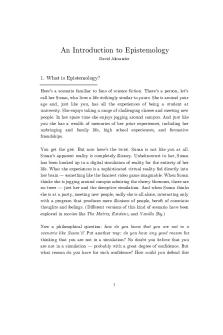
1. An Introduction to Epistemology
- 10 Pages

1. An Introduction to Glaciers
- 6 Pages

Introduction to Sensory Systems
- 4 Pages
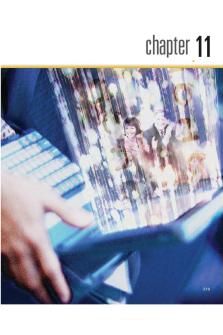
Chapter 11 - Information Systems
- 26 Pages

Introduction to Digital Systems
- 222 Pages
Popular Institutions
- Tinajero National High School - Annex
- Politeknik Caltex Riau
- Yokohama City University
- SGT University
- University of Al-Qadisiyah
- Divine Word College of Vigan
- Techniek College Rotterdam
- Universidade de Santiago
- Universiti Teknologi MARA Cawangan Johor Kampus Pasir Gudang
- Poltekkes Kemenkes Yogyakarta
- Baguio City National High School
- Colegio san marcos
- preparatoria uno
- Centro de Bachillerato Tecnológico Industrial y de Servicios No. 107
- Dalian Maritime University
- Quang Trung Secondary School
- Colegio Tecnológico en Informática
- Corporación Regional de Educación Superior
- Grupo CEDVA
- Dar Al Uloom University
- Centro de Estudios Preuniversitarios de la Universidad Nacional de Ingeniería
- 上智大学
- Aakash International School, Nuna Majara
- San Felipe Neri Catholic School
- Kang Chiao International School - New Taipei City
- Misamis Occidental National High School
- Institución Educativa Escuela Normal Juan Ladrilleros
- Kolehiyo ng Pantukan
- Batanes State College
- Instituto Continental
- Sekolah Menengah Kejuruan Kesehatan Kaltara (Tarakan)
- Colegio de La Inmaculada Concepcion - Cebu
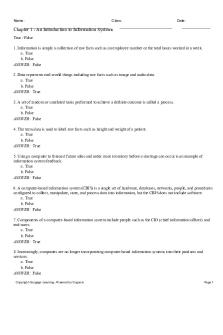
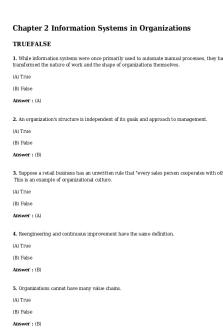
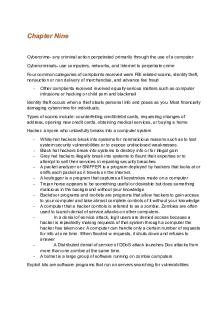



![OBrien - Introduction to Information Systems [2010]](https://pdfedu.com/img/crop/172x258/zx28ke2j06rw.jpg)



